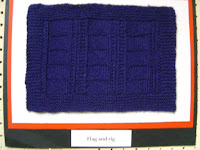"The guernsey came into being as a garment for fishermen who required a warm, hard wearing, yet comfortable item of clothing that would resist the sea spray. The hard twist given to the tightly packed wool fibres in the spinning process and the tightly knitted stitches, produced a finish that would "turn water" and is capable of repelling rain and spray."
"The guernsey was traditionally knitted by the fishermen's wives and the pattern passed down from mother to daughter through the generations"
"Through trade links established in the 17th century, the guernsey found favour with seafarers around the British Isles, and many coastal communities developed their own "ganseys" based on the original pattern. Whilst the classic guernsey pattern remained plain, the stitch patterns used became more complex the further north the garment spread, with the most complex evolving in the Scottish fishing villages."
"The rib at the top of the sleeve is said to represent a sailing ship’s rope ladder in the rigging, the raised seam across the shoulder a rope, and the garter stitch panel waves breaking upon the beach...drawing inspiration from ropes, chains, waves, nets and sand-prints" [link]
Gansey knit patterns [link]
Interesting article from the V&A about regional knitting in the British Isles. [link]
For example, Fair Isle jumpers...
Although both of these examples of clothing aren't regionally specific to me, I do like how their pattern designs are based on landscapes and the environment of these people. There is also the fact that communities and families had their own designs, which relates to the rest of my research so far.
This will help further my visual research, continuing the idea of breaking bigger images down into simpler forms and motifs that represent something important.
Other objects that could be stripped back into forms and patterns could include all of the different types of knots fishermen would use. Despite their utilitarian purpose, they can often look decorative and complex.





No comments:
Post a Comment